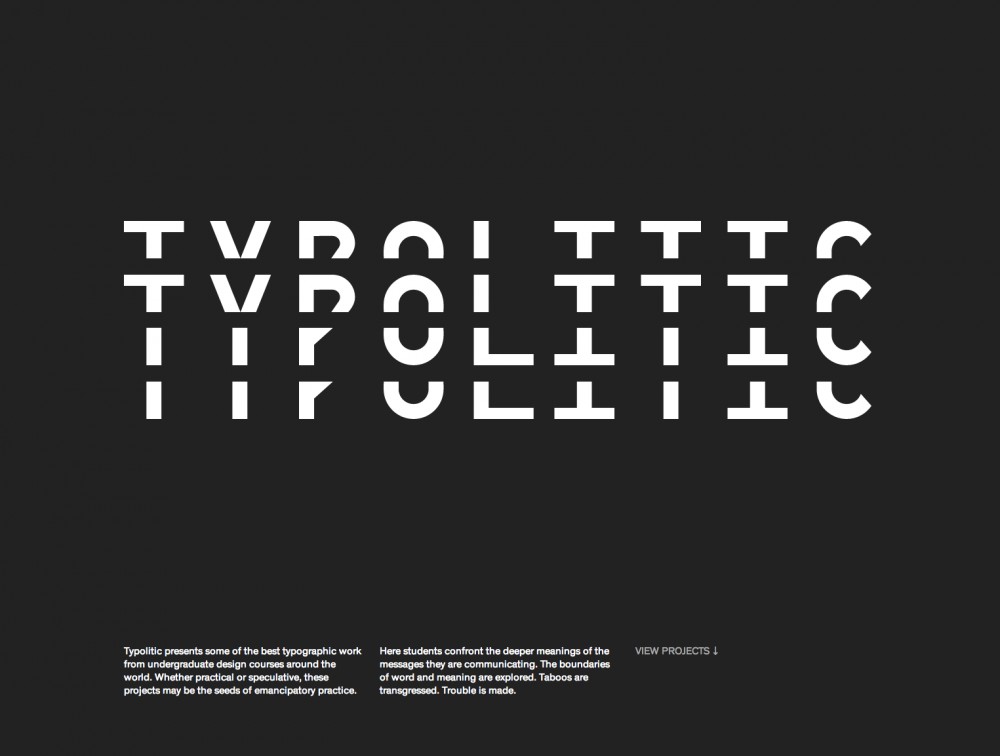Why Typolitic
Why Typolitic
Published on Design Online
There are plenty of blogs and online forums about typography, many of them banal and a few of them wonderful. They focus on everything from magpie dumps of ‘daily inspiration’, to the technical trifles of typographic minutiae. If I had the time I’d read them all. Most of them however do not consider social context and consequence, do not differentiate between the letterforms of a multinational brand’s logotype and those of a protest poster for example, or even acknowledge that typography is a social and cultural artefact, tool, practice. That it is political.
And so it goes with design and typography education. My own design education was loyally wedded to the ideological imperatives of the marketplace. (Now we can have a debate about the merits of neo-liberal capitalism, but actually at this stage of human history, with natural and social systems rapidly collapsing, I’d rather be debating alternatives.) There is a gradual shift to broader, more critical, and less instrumental course content, especially in post-grad degrees. Undergraduate degrees are the raw, formative stage of a student’s design education, however they typically remain cast in the fossilised resin of formal emphasis and service provision. After all, formal skill development is essential but no more so than critical thinking, especially thinking against demonstrably damaged and damaging systems. And where is the recognition that design itself is complicit?

Inkahoots has been involved with several attempts to redirect design education with admittedly minimal success. I wondered about other, less institutional ways the pedagogy might be influenced. What if tutors and students around the world could encounter exceptional undergraduate work with a social and political commitment? What if the work was critiqued by leading designers, typographers and writers whose own work is referenced in students’ courses, their commentary providing a unique ongoing pedagogical forum with a fascinating feedback loop between the studied and the student? And so Typolitic was concieved. Contributors currently include: designer and founder of Grapus and Atelier Atelier de Création Graphique Pierre Bernard; writer and founder of Eye Magazine and Design Observer Rick Poynor; philosopher and design theorist Tony Fry; media theorist, documentarian and CNN commentator Douglas Rushkoff; designer and typographer Jonathan Barnbrook; designer, writer, educator and Cooper-Hewitt National Design Museum curator Ellen Lupton; designer and typographer Stephen Banham; and exhibition and editorial designer Nick Bell. ABC Radio National arts broadcaster Sarah Kanowski and Publishing Director of Penguin Australia Ben Ball contribute as experts from outside the field.
In the projects collected on Typolitic students examine the visible word in the wider context of social and cultural constructs, and confront the deeper meanings of the messages they are communicating. The boundaries of word and meaning are explored. Taboos are transgressed. Trouble is made.
The familiar, latent typographic knowledge we all have as readers is uprooted for conscious application by designers. Typography becomes a path into expository interrogation, not just of form but context and consequence. Untested assumptions and prejudices are exposed and dismantled. Alternatives are born. Whether practical or speculative, these political projects may be the seeds of emancipatory practice.
The blog itself also argues implicitly for the teaching of typography and design generally as an intrinsically political medium. And its basic ambition is to encourage many more of the kinds of projects it presents.
A concern that I had from the beginning of the project was the general appropriateness of a public, online forum compared to the relatively private sanctuary of a shielded university context that supports risk taking and experimentation. A few potential contributors declined to participate for these reasons, adding that their experience teaching in Universities demonstrated the fundamental importance of personal relationships in mediating this vulnerability. I have a lot of sympathy with this perspective, but hope that Typolitic can have its own benefit. We ask all comments to acknowledge and respect that this is work from students at the beginning of their education as designers, that we all began at the beginning and needed support and encouragement (and that most of us still do!).
Typolitic aims to extend the critical discussion of students’ work out of the classroom, into the public sphere – and beyond the myopia of the marketplace – so that the broader public realm is reinforced as the legitimate domain of their agency.
+
Jason Grant 2014